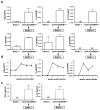Innate and adaptive interleukin-22 protects mice from inflammatory bowel disease
- PMID: 19100701
- PMCID: PMC3269819
- DOI: 10.1016/j.immuni.2008.11.003
Innate and adaptive interleukin-22 protects mice from inflammatory bowel disease
Abstract
Inflammatory bowel disease (IBD) is a chronic inflammatory disease thought to be mediated by dysfunctional innate and/or adaptive immunity. This aberrant immune response leads to the secretion of harmful cytokines that destroy the epithelium of the gastrointestinal tract and thus cause further inflammation. Interleukin-22 (IL-22) is a T helper 17 (Th17) T cell-associated cytokine that is bifunctional in that it has both proinflammatory and protective effects on tissues depending on the inflammatory context. We show herein that IL-22 protected mice from IBD. Interestingly, not only was this protection mediated by CD4+ T cells, but IL-22-expressing natural killer (NK) cells also conferred protection. In addition, IL-22 expression was differentially regulated between NK cell subsets. Thus, both the innate and adaptive immune responses have developed protective mechanisms to counteract the damaging effects of inflammation on tissues.
Conflict of interest statement
LAZ and RAF declare no conflict of interest. GDY, DMV, AJM and SS were employees of Regeneron Pharmaceuticals at the time this work was performed.
Figures







Similar articles
-
T helper cell 1-type CD4+ T cells, but not B cells, mediate colitis in interleukin 10-deficient mice.J Exp Med. 1996 Jul 1;184(1):241-51. doi: 10.1084/jem.184.1.241. J Exp Med. 1996. PMID: 8691138 Free PMC article.
-
Memory/effector (CD45RB(lo)) CD4 T cells are controlled directly by IL-10 and cause IL-22-dependent intestinal pathology.J Exp Med. 2011 May 9;208(5):1027-40. doi: 10.1084/jem.20102149. Epub 2011 Apr 25. J Exp Med. 2011. PMID: 21518800 Free PMC article.
-
Inhibiting PGGT1B Disrupts Function of RHOA, Resulting in T-cell Expression of Integrin α4β7 and Development of Colitis in Mice.Gastroenterology. 2019 Nov;157(5):1293-1309. doi: 10.1053/j.gastro.2019.07.007. Epub 2019 Jul 11. Gastroenterology. 2019. PMID: 31302143
-
Synergy of IL-23 and Th17 cytokines: new light on inflammatory bowel disease.Neurochem Res. 2010 Jun;35(6):940-6. doi: 10.1007/s11064-009-0091-9. Epub 2009 Nov 14. Neurochem Res. 2010. PMID: 19915978 Free PMC article. Review.
-
Innate and adaptive immunity in inflammatory bowel disease.Autoimmun Rev. 2014 Jan;13(1):3-10. doi: 10.1016/j.autrev.2013.06.004. Epub 2013 Jun 15. Autoimmun Rev. 2014. PMID: 23774107 Review.
Cited by
-
Preventive Effect of Vitamin C on Dextran Sulfate Sodium (DSS)-Induced Colitis via the Regulation of IL-22 and IL-6 Production in Gulo(-/-) Mice.Int J Mol Sci. 2022 Sep 13;23(18):10612. doi: 10.3390/ijms231810612. Int J Mol Sci. 2022. PMID: 36142515 Free PMC article.
-
Fibrosis Related Inflammatory Mediators: Role of the IL-10 Cytokine Family.Mediators Inflamm. 2015;2015:764641. doi: 10.1155/2015/764641. Epub 2015 Jun 24. Mediators Inflamm. 2015. PMID: 26199463 Free PMC article. Review.
-
Diverse roles of STING-dependent signaling on the development of cancer.Oncogene. 2015 Oct 8;34(41):5302-8. doi: 10.1038/onc.2014.457. Epub 2015 Feb 2. Oncogene. 2015. PMID: 25639870 Free PMC article.
-
Cellular and molecular mechanisms of intestinal fibrosis.World J Gastroenterol. 2012 Jul 28;18(28):3635-61. doi: 10.3748/wjg.v18.i28.3635. World J Gastroenterol. 2012. PMID: 22851857 Free PMC article.
-
Microbiota-Dependent Effects of IL-22.Cells. 2020 Sep 29;9(10):2205. doi: 10.3390/cells9102205. Cells. 2020. PMID: 33003458 Free PMC article. Review.
References
-
- Aggarwal S, Ghilardi N, Xie MH, de Sauvage FJ, Gurney AL. Interleukin-23 promotes a distinct CD4 T cell activation state characterized by the production of interleukin-17. J Biol Chem. 2003;278:1910–1914. - PubMed
-
- Andoh A, Zhang Z, Inatomi O, Fujino S, Deguchi Y, Araki Y, Tsujikawa T, Kitoh K, Kim-Mitsuyama S, Takayanagi A, et al. Interleukin-22, a member of the IL-10 subfamily, induces inflammatory responses in colonic subepithelial myofibroblasts. Gastroenterology. 2005;129:969–984. - PubMed
-
- Axelsson LG, Landstrom E, Goldschmidt TJ, Gronberg A, Bylund-Fellenius AC. Dextran sulfate sodium (DSS) induced experimental colitis in immunodeficient mice: effects in CD4(+) -cell depleted, athymic and NK-cell depleted SCID mice. Inflamm Res. 1996;45:181–191. - PubMed
-
- Blumberg H, Conklin D, Xu WF, Grossmann A, Brender T, Carollo S, Eagan M, Foster D, Haldeman BA, Hammond A, et al. Interleukin 20: discovery, receptor identification, and role in epidermal function. Cell. 2001;104:9–19. - PubMed
-
- Boniface K, Lecron JC, Bernard FX, Dagregorio G, Guillet G, Nau F, Morel F. Keratinocytes as targets for interleukin-10-related cytokines: a putative role in the pathogenesis of psoriasis. Eur Cytokine Netw. 2005;16:309–319. - PubMed
Publication types
MeSH terms
Substances
Grants and funding
LinkOut - more resources
Full Text Sources
Other Literature Sources
Molecular Biology Databases
Research Materials

